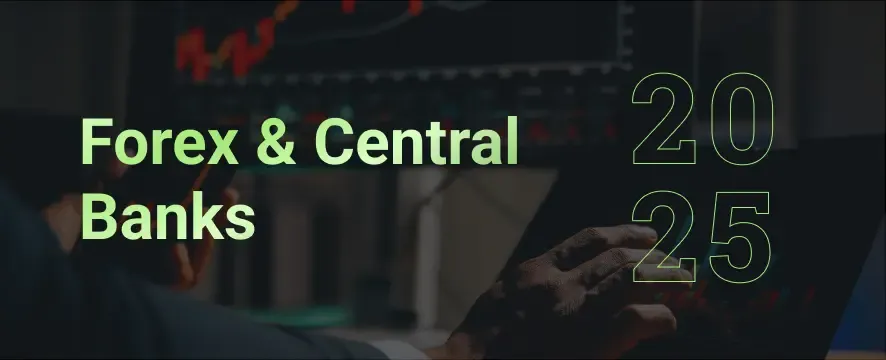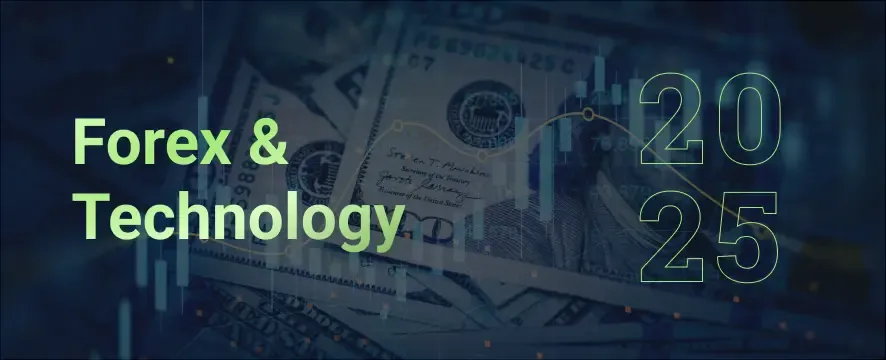13 min read
Share
Forex Trading Statistics for 2025 Revealed, Including Trends, Demographics, and Behavioral Insights
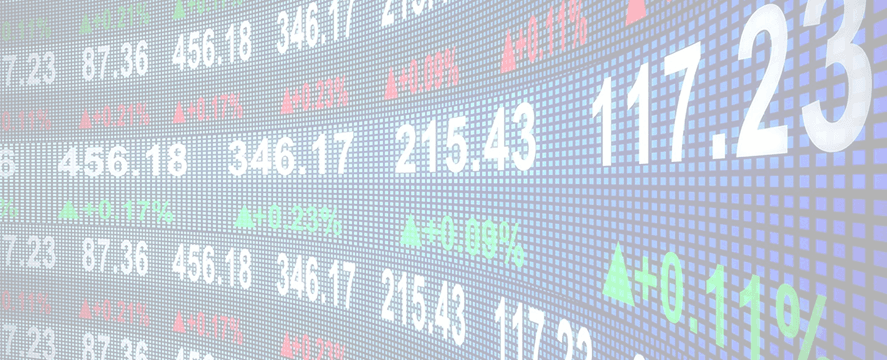
The Forex market is the largest financial market in the world, with a daily volume of Forex transactions exceeding $7.5 Trillion.
This trading volume gives us a lot of insights into the trading activity in the Forex market, particularly highlighting the dominance of major currency pairs such as USD/JPY and EUR/USD, but also highlighting the growth of other emerging currency pairs such as USD/CNY and USD/HKD.
Unlike the stock market or commodities market, the Forex market operates 24 hours a day, 5 days a week. It bridges global economies and enables seamless international trade and investment.
This ease of accessibility makes the Forex market particularly popular amongst both retail traders and institutional investors looking to make money trading forex.
Large financial institutions play a very significant role in the foreign exchange market, facilitating large volumes of trading and contributing large sums of money to the market's unparalleled size and liquidity.
Technological advancements – including the rise of AI, demographic shifts, and the emergence of new market hubs, continue to transform how participants interact with this massive market.
Keep reading for a comprehensive analysis and overview of the trends, behaviors and statistics shaping Forex trading in 2025.
What Will You Learn?
This article will cover the following topics:
Who trades Forex: A detailed breakdown of age, gender, and regional demographics.
Global market statistics, including its size, growth, and key trading hubs.
The transformative role of technology, including AI and blockchain.
Behavioral insights into trading psychology and compulsive trading habits.
Emerging markets and regional trends reshaping the Forex landscape.
The future of Forex trading, including challenges and opportunities.
Behavior and demographics of online forex traders, including preferences for regulated versus unregulated brokers and geographic distribution.
Who Trades The Forex Market?
Forex trading is truly inclusive, attracting participants from all walks of life and social classes. Its low barrier to entry, global reach, and 24-hour operation have democratized access, allowing anyone with an internet connection, a cellphone or laptop, and capital to begin trading.
However, behind this ease of accessibility lies a fascinating diversity in the demographics and motivations of traders.
The Forex market is dominated by major currency pairs like USD/EUR and USD/JPY, with the US dollar the most traded currency. However, emerging currency pairs are gaining significant popularity, typically offering higher potential rewards - with increased levels of risk.
Why People Trade Forex
Forex trading appeals to both institutional and retail participants for its unparalleled liquidity, flexibility, ease of access, and the potential for high returns.
The average forex trading volume has seen a significant increase over time, and its current daily volume underscores the market's immense scale.
Institutional players like banks, hedge funds, and multinational corporations use Forex to hedge risks, facilitate international trade, and execute speculative strategies.
Meanwhile, for retail traders, the Forex market offers a chance to earn an additional source of income, build long-term wealth, or potentially become a full-time job.
Key Components of Forex Trading
The forex market's 24-hour availability makes it very appealing to part-time traders looking to learn to trade Forex outside of their normal day job. Moreover, its 24-hour accessibility makes it a truly 'global' activity for many people in different time zones.
Another key component of Forex trading is leverage, which offers traders the ability to control substantial positions in the Forex market with relatively small sums of capital.
The ability to access leverage is particularly alluring to students, those just starting out in the working world, or people not looking for a significant upfront financial cost.
Trader Demographics
Age Groups
The most popular age group when it comes to Forex trading is working professionals. However, the trading demographic is fairly evenly spread across all age groups:
Under 25 Years Old: (10%) Traders in this age bracket may be drawn to Forex trading by the allure of a flashy lifestyle or the hope of getting rich quickly. However, some may genuinely be exploring trading as a means of working towards financial independence. They will typically trade Forex on mobile apps and may be strongly influenced by social media. Their available trading capital is usually very limited. They may lean more towards high-risk, high-reward strategies such as scalping or trading volatile currency pairs.
25-34 Years Old: (17%) Forex traders in this age demographic are often at the beginning stages of building a financial portfolio or planning for retirement. Most of them have steady jobs and budding careers, with some disposable income to use for trading. These traders are likely to use a mixture of trading strategies, including swing trading and day trading, and may even hold some longer-term positions.
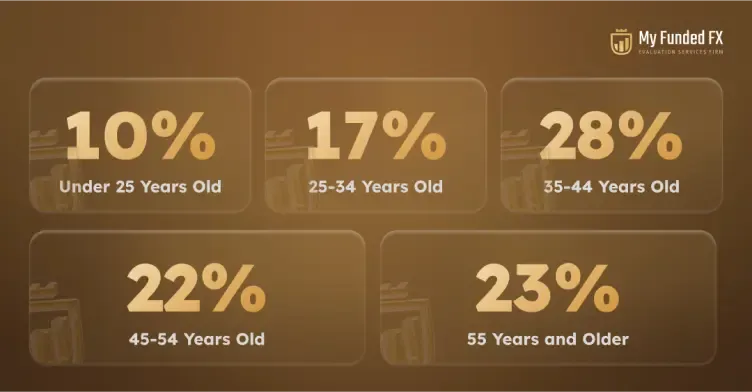
35-44 Years Old: (28%): People in this demographic account for the largest percentage of Forex traders. They typically balance their trading with their professional careers and use a more strategic approach to their trading goals. They typically have very specific goals, such as supplementing their income or financial independence. This group is very likely to use tools and bots to automate their trading as much as possible.
45-54 Years Old: (22%) Forex traders in this demographic are more experienced and use trading to grow their ' nest egg' for retirement or build up a secondary income for when they step away from their '9-5' job. Many people in this category either own businesses or hold a senior role in an organization. Risk management is important to them as they have one eye on retirement.
55 Years and Older: (23%) Forex traders who are older than 55 see trading as a way to generate a consistent second income or manage their wealth during the latter portion of their lives. Moreover, they often view Forex as a way to stay active and mentally sharp. Their schedules are usually very flexible, and they typically have a lot of time to research and monitor the market. They value careful planning and strict risk management in their trading, with an emphasis on capital preservation.
Gender Dynamics
In terms of gender dynamics, men dominate Forex trading, compromising approximately 80% of market participants. However, it's worth noting that women's involvement is steadily rising, particularly in Europe and North America, where they account for 23% and 19% of traders, respectively.
Female traders are noted for their more disciplined, risk-averse approaches, preferring consistency and careful planning over more high-risk, high-reward strategies.
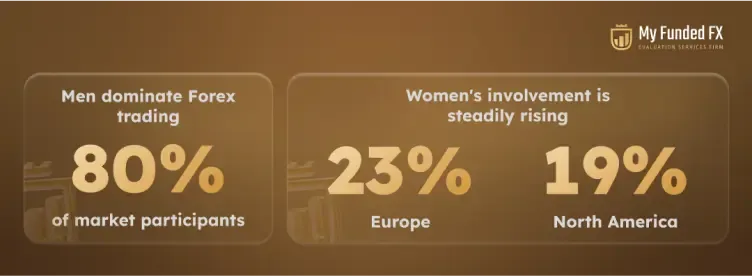
Regional Insights
Asia-Pacific (40%): The Asia-Pacific region is the global leader in Forex trading and is driven by strong financial hubs like Tokyo, Singapore, and Hong Kong. Moreover, rising economic powerhouses like India are also significantly contributing to strong trading volume in this region.
Europe (37%): London remains a hive of activity for Forex trading, handling approximately $2.7 trillion daily. Because its time zone overlaps with both Asian and American trading hours, its influence is particularly notable.
North America (17%): The US Dollar’s dominance ensures the region’s importance. Meanwhile, a strong - and growing retail base contributes to its volume.
Rest of the World (6%): The rest of the world compromises the rest of the Forex trading activity. Although they make up less than 10% of the total number of traders, Forex is a truly global activity.
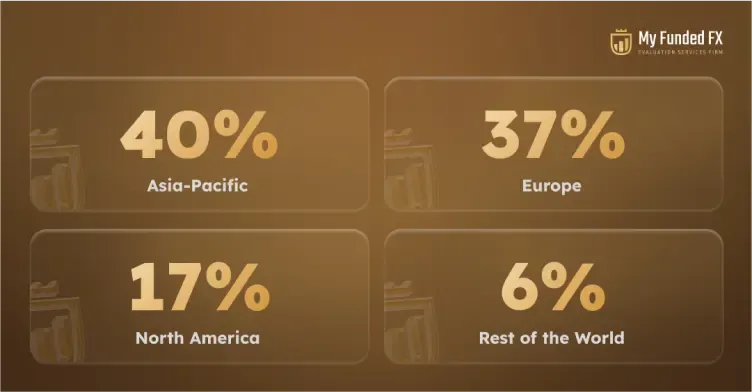
Global Foreign Exchange Market Statistics
The Forex market is the primary mechanism for currency exchange, and facilitates international trade, enabling corporations and governments to manage risks. Its sheer size and deep liquidity make it indispensable to global commerce, trade, and investment.
Market Size and Growth
In 2025, the Forex market continues to thrive and attract new traders as well as emerging market economies. The following statistics highlight this ongoing boom.
Average Daily Trading Volume: The daily volume in the Forex market exceeds $7.5 trillion. This volume marks an impressive 6% year-on-year growth.
Retail Trading Boom: The number of retail traders has increased by 15% in five years. This growth is largely attributed to the growth of social media and mobile apps.
Emerging Markets Growth: Emerging countries like Brazil, South Africa, and Indonesia are experiencing double-digit annual growth - fueled by rising financial literacy and improved internet access.
This growth underscores the market’s resilience - despite global economic challenges and uncertainty. Forex remains the go-to market for institutions and retail traders seeking liquidity and flexibility.
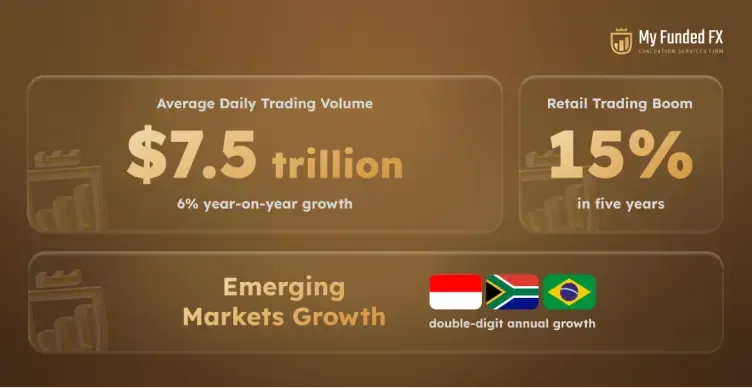
Major Currencies Traded
Forex is always traded in currency pairs, with one currency being the 'base' currency and the other currency the 'quote' currency.
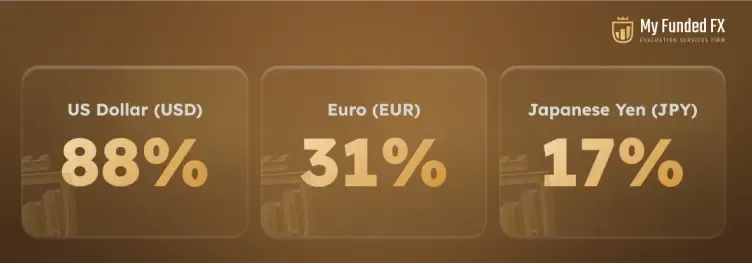
Major Currencies Traded
Forex is always traded in currency pairs, with one currency being the 'base' currency and the other currency the 'quote' currency.
The following are the most prominent currencies traded:
US Dollar (USD): The US dollar is involved in 88% of all trades, reflecting its role as the world’s reserve currency. The EUR/USD and USD/JPY pairs are among the most frequently traded currency pairs. These commonly traded currency pairs are known as major currency pairs.
Euro (EUR): The Euro is traded in approximately 31% of all Forex trades, serving as a key currency in global trade.
Japanese Yen (JPY): The Japanese Yen is traded in 17% of all trades. It is regarded as a safe-haven currency and is very popular during times of increased economic uncertainty and volatility.
There is an increase in the prominence of emerging currencies like the Chinese Yuan and the Indian Rupee, highlighting a shifting global financial landscape.
Key Trading Hubs
Forex trading activity is strongly concentrated in a few global hubs, with London leading the way:
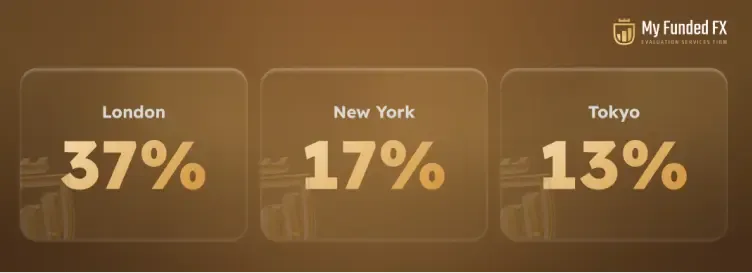
London (37%): The world’s Forex capital benefits from its strategic time zone and financial expertise.
New York (17%): The Dollar’s dominance and the US’s economic strength underpin New York’s influence.
Tokyo (13%): Tokyo is a vital hub for Asian markets. Tokyo is driven by the Yen’s importance in global trade.
Technology’s Role in Forex Trading
Technological innovation is transforming Forex trading at a rapid rate, making it more accessible, efficient, and data-driven than ever. At the forefront of this technical revolution are AI and algorithmic trading.

AI and Algorithmic Trading
AI tools now power 15% of Forex trades, enabling traders to analyze vast datasets and execute strategies with precision. Algorithmic trading, once reserved for institutions, is becoming increasingly popular among retail traders, with many Forex platforms now offering customizable bots.
Blockchain and Cryptocurrency
Blockchain technology is streamlining Forex by reducing transaction costs and enhancing transparency. Meanwhile, 25% of traders now include cryptocurrency pairs in their portfolios, reflecting the growing integration of cryptocurrency into Forex markets.
Forex Trading Platforms and Brokers
Forex trading platforms are a cornerstone of the global Forex market, providing traders with the tools and infrastructure needed to engage in currency trading.
With the influx of new traders into the market, the demand for reliable, efficient, and fast trading platforms has skyrocketed.
Most Popular Trading Platforms
In the vast landscape of Forex trading, certain platforms have emerged as favorites among traders:
MetaTrader 4 (MT4) and MetaTrader 5 (MT5): These platforms are the gold standard in the Forex market, with more than 10 million users worldwide. The platforms are known for their user-friendly interface and robust features. MT4 and MT5 offer advanced charting tools, a plethora of technical indicators, and the ability to automate trading strategies through Expert Advisors (EAs).
cTrader: Another popular choice, cTrader is favored for its intuitive design and powerful trading capabilities. It provides a seamless trading experience with advanced charting tools and a wide variety of order types.
NinjaTrader and TradingView: These platforms are also highly regarded, and the offer comprehensive charting and analysis tools. NinjaTrader is particularly popular among futures and Forex traders for its advanced analytics. Meanwhile, TradingView is known for its social trading features and extensive community of traders.
Largest Forex Brokers
The role of Forex brokers is pivotal in facilitating trades and providing market access. Here are some of the largest Forex brokers in the world:
IC Markets: As the largest online Forex broker, IC Markets boasts an impressive daily average trading volume of $22.68 billion. Known for its low spreads and fast execution speeds, IC Markets is a top choice for many traders.
Forex.com: This broker has a daily average trading volume of $18.6 billion. It offers a comprehensive suite of trading tools, market analysis, and educational resources, making it a preferred broker for many.
XM, Pepperstone, and FxPro: These brokers are also notable for their extensive range of services, including advanced trading platforms, market insights, and dedicated customer support. They cater to a global customer base, providing a reliable and secure trading environment.
Psychology and Behavioral Insights
Compulsive Trading Habits
According to recent stats, approximately 6% of traders exhibit compulsive trading behaviors, such as overtrading (trading too often) or relying excessively on high-leverage positions.
These compulsive trading habits typically stem from either fear of losing money or greed to make more money.
Keys to Managing Emotions
Successful traders manage their emotions by maintaining discipline in their trading, sticking to their trading plan, and developing emotional resilience.
Moreover, they take time to journal and document their progress - and lessons learned along the way.
Forex Risk and Regulation
Forex trading, while potentially very lucrative, carries a substantial level of risk. Understanding these risks and the broader regulatory landscape is crucial for anyone risking capital in the Forex market.
Forex Risk Management
Effective risk management is the bedrock of successful Forex trading. Here are some essential strategies that form the framework for successful risk management:
Stop-Loss Orders: These orders automatically close a trade at a predetermined price, limiting potential losses. They are arguably the most important tool for managing risk and protecting capital.
Position Sizing: Determining the appropriate size of a trade based on account size and risk tolerance is crucial. Proper position sizing helps manage exposure and avoid catastrophic losses. A good rule of thumb is to risk no more than 1-2% of your trading capital per trade.
Risk-Reward Ratios: This involves setting a target profit level relative to the amount of risk taken. A favorable risk-reward ratio ensures that potential profits outweigh potential losses for any given trade.
Staying Informed: Keeping abreast of market news and analysis is essential for making informed trading decisions. Economic indicators, geopolitical events, and market sentiment can all impact currency prices.
Emerging Markets
Latin America and Africa are experiencing unprecedented growth in Forex participation. Countries like Brazil, Nigeria, and South Africa are leveraging increased internet access and education initiatives to bring Forex trading to broader populations.
In Latin America, currency volatility and economic reforms have fueled interest, while Africa’s young, entrepreneurial population is driving innovation in mobile trading.
The Future of Forex Trading
The future of Forex lies at the intersection of technology, regulation, and demographics. AI and blockchain will continue to reshape the market, while emerging markets will contribute to its growth.
However, challenges like economic volatility and regulatory shifts will require traders to remain adaptive to the changing global landscape.
Conclusion
Forex trading in 2025 is more than just a financial market; it’s a global ecosystem. With its immense scale, technological integration, and diverse participant base, it remains a cornerstone of global finance.
Success in Forex trading demands strict discipline, knowledge, and the ability to adapt to a constantly evolving environment. Those who can leverage technology and stay ahead of global economic shifts are likely to come out ahead in the days to come.
Join our community
Get an insight from other users about SeacrestFunded and their experiences. 131K+ members and counting

